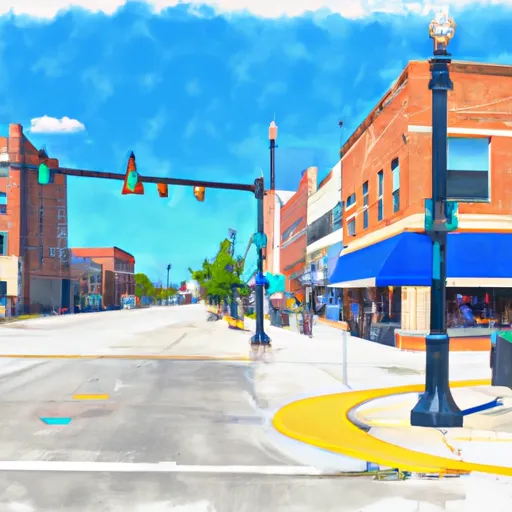-
 Snoflo Premium
Snoflo Premium
Get unlimited access to all our content
With no Ad interruptions! - Start Your Free Trial Login with existing account
Michigan-City
Eden Index
Climate
8.0
•
Recreation
7.0
•
Community
2.1
•
Safeguard
6.2/10

Michigan City is a charming city located in Indiana, sitting on the southern coast of Lake Michigan. Its climate is classified as humid continental, experiencing warm summers and cold winters. Average temperatures range from 20°F (-7°C) in winter to 80°F (27°C) in summer. The city receives abundant rainfall throughout the year, with an average precipitation of 39 inches (990 mm), often resulting in high humidity levels.
As for hydrology constituents, Michigan City benefits from its proximity to Lake Michigan. The lake not only offers stunning vistas, but also provides opportunities for various water activities, such as swimming, boating, and fishing. The city also has several small lakes and ponds within its limits, contributing to its water-based recreational options.
Outdoor enthusiasts will enjoy the many recreational opportunities available in Michigan City. Washington Park, located along Lake Michigan, offers a sandy beach, picnic areas, and trails for walking or jogging. The Indiana Dunes National Park is a short drive away and provides opportunities for hiking, bird-watching, and camping. Additionally, there are golf courses, parks, and nature preserves in the area, making Michigan City an ideal destination for those seeking outdoor adventures.
What is the Eden Index?
The Snoflo Eden Index serves as a comprehensive rating system for regions, evaluating their desirability through a holistic assessment of climate health, outdoor recreation opportunities, and natural disaster risk, acknowledging the profound impact of these factors on livability and well-being.
Climate Health Indicator (CHI): 8.0
Michigan-City receives approximately
1000mm of rain per year,
with humidity levels near 82%
and air temperatures averaging around
10°C.
Michigan-City has a plant hardyness factor of
6, meaning
plants and agriculture in this region thrive during a short period during spring and early summer. Most
plants will die off during the colder winter months.
By considering the ideal temperature range, reliable water supplies, clean air, and stable seasonal rain or snowpacks, the Climate Health Indicator (CHI) underscores the significance of a healthy climate as the foundation for quality living.
A healthy climate is paramount for ensuring a high quality of life and livability in a region, fostering both physical well-being and environmental harmony. This can be characterized by ideal temperatures, reliable access to water supplies, clean air, and consistent seasonal rain or snowpacks.
Weather Forecast
Streamflow Conditions
Southwestern Lake Michigan
Area Rivers
Southwestern Lake Michigan
Snowpack Depths
Southwestern Lake Michigan
Reservoir Storage Capacity
Southwestern Lake Michigan
Groundwater Levels
Recreational Opportunity Index (ROI): 7.0
The Recreational Opportunity Index (ROI) recognizes the value of outdoor recreational options, such as parks, hiking trails, camping sites, and fishing spots, while acknowledging that climate plays a pivotal role in ensuring the comfort and consistency of these experiences.
Access to outdoor recreational opportunities, encompassing activities such as parks, hiking, camping, and fishing, is crucial for overall well-being, and the climate plays a pivotal role in enabling and enhancing these experiences, ensuring that individuals can engage in nature-based activities comfortably and consistently.
Camping Areas
| Campground | Campsites | Reservations | Toilets | Showers | Elevation |
|---|---|---|---|---|---|
| West Boggs Park | 220 | 528 ft | |||
| Owen Putnam State Forest | 35 | 597 ft | |||
| Dubois County Park | 32 | 575 ft | |||
| Glendale State Fish and Wildlife Area | 120 | 495 ft | |||
| Ferdinand State Forest | 70 | 489 ft | |||
| Vastwood Co Park | 21 | 490 ft | |||
| Martin State Forest | 25 | 743 ft | |||
| Lincoln State Park | 270 | 467 ft | |||
| Crane MWR Military | None | 594 ft | |||
| Montgomery Rec Park | None | 515 ft |
Nearby Ski Areas
Catastrophe Safeguard Index (CSI):
The Catastrophe Safeguard Index (CSI) recognizes that natural disaster risk, encompassing floods, fires, hurricanes, and tornadoes, can drastically affect safety and the overall appeal of an area.
The level of natural disaster risk in a region significantly affects safety and the overall livability, with climate change amplifying these risks by potentially increasing the frequency and intensity of events like floods, fires, hurricanes, and tornadoes, thereby posing substantial challenges to community resilience and well-being.
Community Resilience Indicator (CRI): 2.1
The Community Resilience Indicator (CRI) recognizes that education, healthcare, and socioeconomics are crucial to the well-being of a region. The CRI acknowledges the profound impact of these elements on residents' overall quality of life. By evaluating educational resources, healthcare accessibility, and economic inclusivity, the index captures the essential aspects that contribute to a thriving community, fostering resident satisfaction, equity, and social cohesion.

